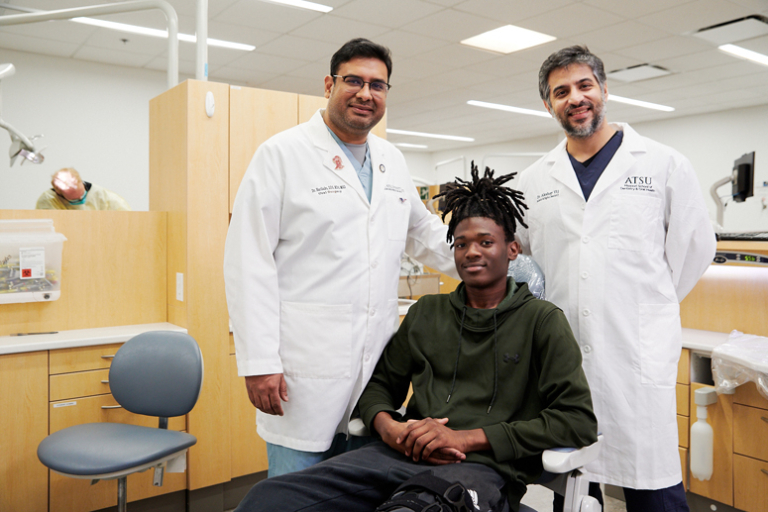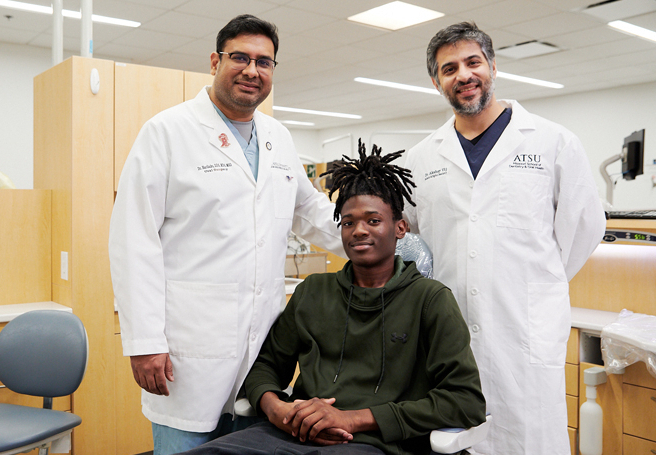ATSU-MOSDOH faculty combine expertise and innovation for complex patient case at the St. Louis Dental Center
Posted: July 17, 2024
When Derrion Smith walks into the St. Louis Dental Center, he is greeted as if he’s family. From reception to the clinic floor, everyone smiles and says hello, calling him by name. The dental center staff know him well. They’ve watched him grow up.
As a patient, Derrion knows his way around the clinic – he’s been there dozens of times over the last five years. He is now 18 and a recent high school graduate, college-bound in the fall. These days, he only comes in periodically. His dental visits are mostly cleanings and follow-up appointments for what started as a serious oral health issue.
A RARE, COMPLEX PATIENT CASE
Derrion first noticed the problem when he was about 10 years old. He remembers a foul taste coming from his gums. The left side of his jaw was slowly swelling, a cyst quietly forming below his teeth.
Because of the cyst’s location and Derrion’s lack of additional symptoms, the problem was not immediately noticeable. However, by age 13, this cyst had grown so large, it caught the attention of a teacher who thought Derrion had been eating candy in class, which was not allowed. After Derrion explained it wasn’t candy in his cheek and showed his gums to her, the teacher called Derrion’s mother, T’Sheka Smith, to discuss the issue.
T’Sheka then took Derrion to a general dentist who referred them to the nearby St. Louis Dental Center for further evaluation. This visit began a long series of appointments where T’Sheka would be by his side, every step of the way.
At the dental center, which is a partnership of ATSU’s Missouri School of Dentistry & Oral Health (ATSU-MOSDOH) and Affinia Healthcare, the Smiths met their care team, including Prashanth K. Haribabu, DDS, MDS, BDS, MSD, and Akshay Vij, BDS, ACT, FAGD. Dr. Haribabu is an assistant professor and specialty care unit director for oral & maxillofacial surgery, and Dr. Vij is an associate professor and specialty care unit director of esthetic & digital dentistry.
To begin, Dr. Haribabu performed a thorough inner and outer evaluation of Derrion’s jaw. Then, the team took a 2D X-ray, which showed something alarming – a large lesion measuring 7 centimeters by 4 centimeters, extending deep into the jawbone.
To get a better view of the lesion under the surface, Dr. Vij used cone-beam CT technology to take a 3D X-ray of the jaw, which provided advanced imaging of the lesion and showed where the dental roots and nerves had shifted. This 3D scan would later become a key element in Derrion’s treatment plan.

After a biopsy, Dr. Haribabu diagnosed the lesion as an odontogenic keratocyst (OKC), an aggressive type of jaw cyst with a high recurrence rate. While OKCs are common in older age groups, Derrion was the first patient at the dental center with an OKC of that size for his age group.
As Dr. Haribabu told the Smiths about the cyst, he explained the severity of Derrion’s case. At that point, the jawbone was “paper thin” because the cyst had destroyed so much hard tissue. Left untreated, the cyst would continue to grow and further destroy the jawbone, leading to a broken jaw, reconstructive surgery, and possible facial disfigurement, a situation with devastating effects on such a young patient.
“It is not uncommon for a patient to lose part of the jaw. Essentially, you have to cut out an entire section,” Dr. Vij says. “This is a 13-year-old kid who would have to have his jaw rebuilt prosthetically.”
An urgent plan was needed to keep the cyst from growing – and coming back. However, Dr. Haribabu wanted to take a conservative treatment approach, for Derrion’s sake and because of his mother’s request to keep as much of his jaw intact as possible, including all of his teeth.
“I was very nervous,” T’Sheka says. “I was more nervous for my son because of all he had to go through.”
Dr. Haribabu and the team decided the best course of action was through marsupialization and enucleation of the cyst. These techniques involve two surgeries: one to shrink the cyst to a manageable size, and the second to completely remove the cyst, which is critical to prevent recurrence.
The Smiths recall feeling overwhelmed when they learned about the surgeries Derrion would need, and the steps for recovery. As reality set in, they knew it would be a long process.
“At the time, I didn’t know what to think. I was nervous,” Derrion says. “Of course, once I realized they were good and knew what they were doing, I was in good hands.”
CONSERVATIVE TREATMENT WITH INNOVATIVE PLANNING
Surgical removal of cysts requires careful planning to avoid vital nerves and arteries, particularly in the complex anatomy of the head and neck. To better visualize and plan his surgical approach, Dr. Haribabu collaborated with Dr. Vij to print a 3D model of Derrion’s jaw.
“3D printing helps bring the X-ray into the physical world,” Dr. Vij says. “This was necessary from a surgical planning perspective and a patient education perspective. Showing a patient a screen with an X-ray doesn’t mean much to them, but showing them a 3D model with the extent of the disease is really powerful.”
Using advanced imaging software and his digital dentistry expertise, Dr. Vij produced a 3D model from the original 3D cone-beam CT scan. These types of models are often printed in one color, but for this complex case, Dr. Vij used a special 3D printer, a Stratasys J750, to print a 1-to-1 scale replica of the jaw with multiple colors delineating the different structures. The result was a clinical masterpiece.
“That was the key; I could hold his jaw in my hand,” Dr. Haribabu says. “It was exactly like a blueprint.”

The importance of a surgeon being able to visualize and touch the structures they will be handling cannot be overstated. 3D models, including the model used in Derrion’s treatment plan, allow clinicians to plan their approach, anticipate challenges, and prepare solutions, possibly reducing operating time, minimizing errors, and alleviating mental fatigue.
Leading up to the surgery, Dr. Haribabu still felt a bit anxious, not only because of the pressure to perform this procedure successfully, but also because he was unsure of how Derrion would tolerate such a procedure in an outpatient clinic setting. At the time, the dental center staff did not have access to a hospital operating room.
“These kinds of procedures are typically done in an operating room,” Dr. Haribabu says. “Because the bone was so thin, the pressure from doing the procedure could fracture the jaw. Then, we wouldn’t have the option of fixing the jaw in the clinic. That is another reason we had to take a conservative approach.”
On the day of the first surgery, Dr. Haribabu conducted the procedure according to plan without any complications. He says Derrion was a “real trooper” for enduring the surgery with only local anesthesia.
During the procedure, the team modified a nasal trumpet, a flexible silicone tube normally used for giving anesthesia, and placed it as an irrigation device into his jaw. This trumpet reduced pressure on the cyst, allowing it to drain slowly while allowing the jawbone to regrow. With this device sutured in place, Derrion had strict instructions to not eat anything hard on that side of his mouth and to keep the cyst clean by flushing it often with salt water.
“We had to be innovative,” Dr. Haribabu says. “Usually, a tooth would be removed first in a situation like this. However, I didn’t want to disappoint his mother, and I attempted to save as many teeth as possible.”
Following surgery, Derrion was re-evaluated multiple times a month for three months, ensuring the nasal trumpet was staying in place and the cyst was decompressing properly. Then, he was evaluated once every three months until the cyst had decompressed enough and new, healthy bone was beginning to form.
“Dr. Haribabu’s treatment approach in an outpatient setting is an example of how we are providing access to care,” Dr. Vij says, speaking to the St. Louis Dental Center’s mission to serve the community and improve community health. “If you add the time and money associated with being in a hospital, that’s a big reason why many patients don’t end up getting care. We are able to provide high-quality care at a minimal cost.”
Almost one year after his initial surgery, Derrion had his second surgery to completely remove the cyst. Because the cyst had shrunk and there was still a lack of supporting bone, one of Derrion’s teeth also had to be removed. However, that tooth had cystic fragments attached to its roots, so removal helped ensure the cyst would not grow back.
“It wasn’t the most comfortable time,” Derrion says. “It was a process. I’m glad they got it done.”
Eighteen months after the second surgery, updated 3D imaging showed Derrion’s jaw had healed successfully. Today, there is still no sign of recurrence, and Derrion’s jaw looks as if he never had a cyst at all.

SUCCESSFUL OUTCOME AND IMPROVED EDUCATION
Surgical intervention is clearly necessary for a successful outcome in a case like Derrion’s, but so are the follow-up appointments and following the dentist’s instructions. Everyone involved in his case played an important role, including his mother. The dental center staff credit T’Sheka for ensuring Derrion received the care he needed – he did not miss a single appointment throughout the entire process.

As for the gap where the one tooth was removed, Dr. Haribabu had a plan for that, too. When Derrion’s wisdom tooth grows in, it will push the remaining teeth on that side of his mouth forward, filling the gap and giving the appearance of a full set of teeth.
Throughout his arduous treatment and recovery, Derrion and his mother have become advocates for seeing a dentist regularly and have even brought other family members to the clinic for care. Dental checkups, and X-rays taken as appropriate, are critical for good oral health, Dr. Haribabu says. Current guidelines recommend visiting a dentist as early as age 1.
As clinicians who are also teachers, Drs. Haribabu and Vij use every opportunity to educate their patients, as well as ATSU-MOSDOH students, who spend much of their clinical education at the dental center. In fact, many students who rotated through the oral surgery unit in the last five years have been involved in Derrion’s case.
Furthermore, his case is helping educate new classes of students. Following Derrion’s second surgery, Dr. Vij used the updated 3D cone-beam CT scan to print another multicolored 3D model. This postoperative model and the original pre-operative model serve as visual aids for students to gain a better understanding of the oral structures and treatment approach.
“Our goal is always to teach the next generation of dentists,” Dr. Vij says. “This case is now part of our case reports. It’s part of our lectures. It helps every subsequent class.”
Advanced technology and 3D printing proved to be valuable elements of this patient case, although Drs. Haribabu and Vij emphasize the success of this treatment, or any treatment, depends on the knowledge and experience of the surgeon and care team. Dental treatments have many pros and cons, and clinicians must communicate these pros and cons to their patients to determine the best care option. They also must rely on their judgment and skill, while considering the whole patient.
“Technology is a tool to visualize, it’s a tool to plan, it’s having a model in your hand,” Dr. Vij says. “But the skill and experience a surgeon brings to the table is huge to execute any treatment. That’s a human element.”
To learn more about Derrion’s case, please read the online case report at atsu.edu/case-report
